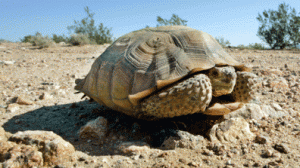
The 550-megawatt facility will use First Solar’s thin film photovoltaic technology and will connect to Southern California Edison’s regional grid. Officials say it will power 165,000 homes and create 630 jobs, adding $336 million into the local economy.
The Deparment of Interior said the project underwent extensive environmental review and was reduced from an initial 19,000 acres to the announced size. The Bureau of Land Management (BLM) has required Desert Sunlight to fund acquisition and enhancement of more than 7,500 acres of suitable habitat for desert tortoise and other wildlife that may be affected by the project.
Wildlife concerns
Environmentalists are not happy with the project, though. Tortoises are the main focus on their concern as they are not sure whether they will survive the changes, although other animals will be affected. “Only time will tell†Donna Charpied, executive director of Citizens for the Chuckwalla Valley told Fox News.
“It would be nice to have solar panels on rooftops, parking lots, next to transmission lines. But a lot of these projects targeting this area are the complete opposite of what the energy plan should beâ€, she added, in reference to the federal government’s plans.
Even more emphatic in his criticism of the desert solar farm is Chris Clarke, a veteran environmental writer, author of the book Walking With Zeke and blogger at Coyote Crossing. He said the announcement by Salazar was the worst birthday present that Joshua Tree National Park could have got. Desert Sunlight’s solar farm lies between the main body of Joshua Tree National Park and the Coxcomb Mountains to the east. Ironically, the announcement coincided with the park’s 75th anniversary.
“The project will disturb intact habitat for a large number of desert animals. The professional biologists at Basin and Range Watch list a dozen sensitive bird species in the area, along with four protected bats, badgers, the “Yuma” subspecies of mountain lion and desert bighorn sheep, as well as the usual dwindling tortoise populationâ€, wrote Chris.
He added that the structure will put “a cork in the migratory bottleneck for many species. Given the likelihood that desert species will need to move generally north in response to increasing temperatures, Desert Sunlight could consign wildlife to succumb to the very climate change it is purported to address.â€
Chris echoed Donna Charpied’s view that solar panels would be better placed on rooftops and other urban settings. It would create good jobs, he said, “without the desert-destroying transmission lines remote projects like Desert Sunlight would requireâ€.
What do you think of this project?
You should follow us here.





